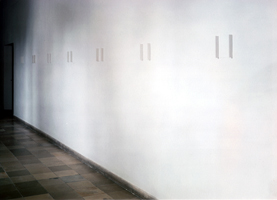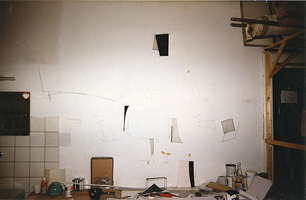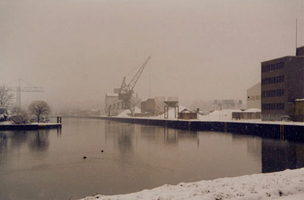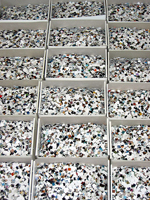topic of my work : thoughts on cognition through visualisation
In the beginning I was unsure about what I do. I love pictures and painting, but I have never asked to myself why. Through my studies and experiences, I began to think about why I paint. Painting is probably one of the answers to the question what and how I observe phenomena. But from where do I get my point of view? Who defines this point of view? Me? With these questions, a word and a new question came to me. The word and the new question are "cognition" and "what is cognition?". |

After that one perceives the colour plane. But I have used a reverse process. Coloured threads were pasted on a white canvas with a 1 mm distance between the threads. Is this therefore painting?
1. Background (white canvas) and foreground (black threads) lose their classical relation to each other.
In this work the background becomes foreground and the foreground becomes background.
2. One sees different shades of grey to black from every viewing point. Which led me to the question „Why do I have to look at pictures from the front?” and „Does one have to paint by hand to create a painting?”


Painting is not necessarily two-dimensional, even if it is so in my head. I visualize myself painting, incorporating all possibilities of composition. I envisage my paintings, the thickness of the paint, how and why I make use of what technique, how I apply the paint, which carrier I use, etc. This means that I use my sense of touch in its everyday meaning as well as the sense of touch of the eyes, not only thinking in colours but also "seeing" weight, temperature, etc.
Colour in painting is strongly influenced by the background (the colour of the wall, the frame) and also by the light surrounding it (darkness or brightness, for example). My thoughts on colour do not only relate to the surface of the canvas.
Before thinking about painting (what is on the canvas), I wanted to find out if there is any need for colour and, if so, why colour is needed. Light contains a multitude of colour nuances. Does this not suffice for painting? As Frank Stella said: "what you see is what you see". There is the portrait, still life, abstract, landscape, etc. - different categories. But actually we only look at the colour, its composition and materiality. So this categorization is only imaginary.


jurierte Ausstellung / Arbeiten von Studierenden
What is a picture? It is one of the many mirrors that we perceive. What does colour mean and what is it for? The relation between colour and shape is also the relation between shape and light. Colour, shape and light are inseparable. How do I perceive? And how do other people perceive? Where does the difference between my perception and the perception of others come from? Why do I paint? What is painting? Before I paint, I want to know where my desire to paint comes from. I want to examine my position. Does this desire result from memories? From everyday living? Things I see, hear…
What I paint and how I paint already is one of the many answers to the question as to how I perceive. Where does this perception come from? Perception is founded on our memories which themselves are founded on our experiences. Neither perception nor memory can exist without experience. Experiences of daily life consciously or subconsciously influence our perception and memory, with visual experience probably being more frequent than experience through our other senses.I arrived in Europe as a tourist and, to this day, keep on photographing like a tourist, a foreigner. But then again I am no longer the Japanese who came to Europe a long time ago. The experiences gained here have influenced me (extensively). After a while I started to ask myself where I actually live and who I actually am.
This personal question about the fundamental significance and meaning of existence drew me and my works to the theme of "Between remembering and forgetting".
"juste à côté de chez moi"
The works "juste à côté de chez moi" (close to home) are exactly what the title suggests. Practically every day I have seen the landscape from the window of my apartment, or just a few steps away from there, and when moving have taken a picture of it as a memory.

 "Überlegungen zum Mechanismus der Erinnerung"
"Überlegungen zum Mechanismus der Erinnerung"
Ausstellungssituation, "Essig Salz und Käse", ArToll Labor e.V., Bedburg-Hau, 1999

"Überlegungen zum Mechanismus der Erinnerung"
Präsentation, "Grünauring 35, Wohnung 3, 1.Stock links", im Rahmen von "FUGE"
www.fuge.ch, Zürich, Schweiz 2004
"Überlegungen zum Mechanismus der Erinnerung"
A memory is composed of many different parts. It can be conscious and subconscious and has an individual meaning for each person, even when the memories come from the same experience. The weight of the memory is different every time, depending on the person, the moment, the situation, etc. Intentional and unintentional pictures were taken on 8 films in Bedburg-Hau, on the site of the "Rheinsche Landesklinik" (Clinic for Psychiatry and Neurology). The resulting approximately 290 (5x7 inch each) pictures were printed.
Each print carries the number of the corresponding film and picture. Some prints are cut to 1/3 inch by 1/3 inch, others are left uncut. The pieces of each cut picture are kept together in a filmcase (numbered corresponding to film and picture), to be collated/pasted on the panel later. Some pieces left in the filmcase are not collated/pasted. Each finished work consists of the pieces of only one print.
"ZWISCHEN ERINNERN UND VERGESSEN"
The photo pieces come from prints of my personal shots capturing different situations, intentionally or by chance. I cut these prints into 1 x 1 cm pieces. These pictures were taken over many years and more will be added.

"sur la structure de l'image / de la perception"
"sur la structure de l'image / de la perception"
I cut prints of my own photos, taken since 1989, into pieces of 1 x 1 cm by hand. This action is part of the work "ZWISCHEN ERINNERN UND VERGESSEN" (Between remembering and forgetting) - see also performance. For "sur la structure de l'image / de la perception" a section of these photo pieces is pasted on 12 multiplex panels of 120 x 180 cm each in random order. The 12 panels correspond to a 135 mm film with 12 pictures on a scale of 50 : 1. The distance between the panels is in approximate accordance with the distance between the pictures on a 135 mm film (50 : 1). The wall for presenting the panels should therefore be 25 m long. Alternatively a presentation in two groups (of 6 panels each) or three groups (of 4 panels each) is possible. This would correspond to the standard size of developed negative strips in Germany, France and Japan. All 12 panels should be exposed together.

Judy Dunaway Balloon Quartet, 09.07.2002, WIM, Zürich, Schweiz


"Remembering memory"
Is my memory made of "my memory itself" or does it exist "through the photos and/or the narrative"? How do my memories of certain situations relate to those memories that are linked with souvenir photos?
During my most recent visit to Japan, I had a look at my mother's photo albums. I took pictures of those photos that evoked memories in me of the depicted situation. The new photos are out of focus, the motifs are often crooked or uncut, and the pages of the albums are visible. The photos are scanned and, according to the actual space, presented in a size that does not allow instant full view of the picture. These large-scale souvenir photos will be composed of A4 prints which have been printed on normal inkjet home printers. As the printer's ink is not very light-fast, the prints will become more and more indistinct in the course of time and the colours will slowly vanish.
For Japanese tourists Lucerne is the epitome, the symbol of a Swiss town and a popular holiday destination. The "Lion Monument” is an integral part of every city tour of Lucerne, just like the group photo in front of the lion.
"kult.our” was a city tour by Lucerne’s free theatre scene, for the people of the city, with stations in public space and the town’s free theatres. In front of the „Lion Monument” I told the „kult.our” group, in Japanese, the story of the "Lion of Lucerne” which was erected as a reminder of the courage and loyality of the Swiss Guard,
devastatingly beaten defending King Louis the 16th of France. Most of the „kult.our” participants were from Lucerne
and heard my tour about „their” lion monument in Japanese... Eventually, there was the obligatory group photo.
Tourists were observed as tourists, and because of the tourists locals became touristic objects.
In exactly the same way theatre group and audience became observed objects too.


"collection - categorization - cognition"
"collection - categorization - cognition"
Many memories and experiences do not have the great impact of first impressions. Cognition arises through the collecting of memories and experiences with the help of categorisation, - and all these actions are interdependent and influence each other. At the background of these processes is the pleasure in order (collection and categorisation), and “understanding/understood” develops through these processes.
Cognition is formed from the collection of memories, experiences, knowledge of what one has learned, and their categorisation, even though the individual action and its real importance is more or less “forgotten” (unimportant). In this project the fly becomes a symbol of the individual memory.
A individual fly and individual memory do not really have such a big importance. But something undescribable develops.


















